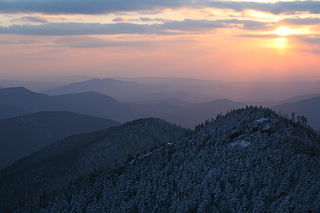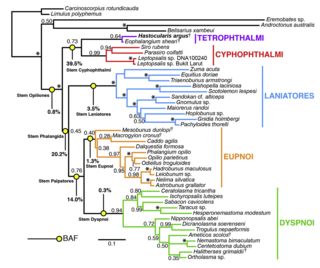
The Appalachian Mountains, often called the Appalachians, are a mountain range in eastern to northeastern North America. The term "Appalachian" refers to several different regions associated with the mountain range, and its surrounding terrain. The general definition used is one followed by the United States Geological Survey and the Geological Survey of Canada to describe the respective countries' physiographic regions. The U.S. uses the term Appalachian Highlands and Canada uses the term Appalachian Uplands; the Appalachian Mountains are not synonymous with the Appalachian Plateau, which is one of the provinces of the Appalachian Highlands.

The Opiliones are an order of arachnids, colloquially known as harvestmen, harvesters, harvest spiders, or daddy longlegs. As of July 2024, over 6,650 species of harvestmen have been discovered worldwide, although the total number of extant species may exceed 10,000. The order Opiliones includes five suborders: Cyphophthalmi, Eupnoi, Dyspnoi, Laniatores, and Tetrophthalmi, which were named in 2014.

Great Smoky Mountains National Park is a national park of the United States in the southeast, with parts in North Carolina and Tennessee. The park straddles the ridgeline of the Great Smoky Mountains, part of the Blue Ridge Mountains, which are a division of the larger Appalachian Mountain chain. The park contains some of the highest mountains in eastern North America, including Kuwohi, Mount Guyot, and Mount Le Conte. The border between the two states runs northeast to southwest through the center of the park. The Appalachian Trail passes through the center of the park on its route from Georgia to Maine. With 13 million visitors in 2023, the Great Smoky Mountains National Park is the most visited national park in the United States.

The Great Smoky Mountains are a mountain range rising along the Tennessee–North Carolina border in the southeastern United States. They are a subrange of the Appalachian Mountains and form part of the Blue Ridge Physiographic Province. The range is sometimes called the Smoky Mountains, and the name is commonly shortened to the Smokies. The Smokies are best known as the home of the Great Smoky Mountains National Park, which protects most of the range. The park was established in 1934 and, with over 11 million visits per year, is the most visited national park in the United States.

Cyphophthalmi is a suborder of harvestmen, colloquially known as mite harvestmen. Cyphophthalmi comprises 36 genera, and more than two hundred described species. The six families are currently grouped into three infraorders: the Boreophthalmi, Scopulophthalmi, and Sternophthalmi.

Sabacon cavicolens is a species of harvestman.

Sabacon is a genus of the monotypic harvestman family Sabaconidae, with 59 species.

Troglosironidae is a family of harvestmen with seventeen described species in a single genus, Troglosiro, which is found on the island of New Caledonia, in the Pacific Ocean.

Ischyropsalididae is a family of harvestmen with 35 described species in 3 genera, found in Europe and North America.

Harvestmen (Opiliones) are an order of arachnids often confused with spiders, though the two orders are not closely related. Research on harvestman phylogeny is in a state of flux. While some families are clearly monophyletic, that is share a common ancestor, others are not, and the relationships between families are often not well understood.

In the central and southern Appalachian Mountains of Eastern North America, a cove is a small valley between two ridge lines that is closed at one or both ends.

Cryptomaster behemoth is an opilionid arachnid inhabiting large woody debris and bark microhabitat in mature coniferous or mixed coniferous and hardwood forests of the central Cascade Mountains of Oregon, with all initially discovered localities in Lane County.

Paranonychus is a genus of harvestman in the family Paranonychidae. There are at least three described species in Paranonychus.

Ortholasmatinae is a subfamily of harvestmen in the family Nemastomatidae with 27 described species in 7 genera. They are found in temperate and often mountainous regions of the Northern Hemisphere.
Speleomaster is a genus of armoured harvestmen in the family Cryptomastridae. There are at least two described species in Speleomaster, both found in lava tubes of the Snake River Plain in southern Idaho.
The Hickory Nut Gorge green salamander is a species of lungless salamander in the family Plethodontidae. It is endemic to the Hickory Nut Gorge in the state of North Carolina in the United States.

Forsteropsalis photophaga, also known as the glow-worm hunter, is a species of long-legged harvestman in the family Neopilionidae. This species is endemic to New Zealand, found in North Island caves in the vicinity of Waitomo. The name "photophaga" comes from their habit of feeding on the luminescent larvae, pupae, and adults of the New Zealand glow-worm Arachnocampa luminosa.

Algidia is a genus in the harvestman family Triaenonychidae. It is endemic to New Zealand and currently includes 7 species and several subspecies.

Sorensenella is a genus in the harvestman subfamily Sorensenellinae in the family Triaenonychidae. It is endemic to New Zealand and currently includes three species and several subspecies. Members of this genus have large pedipalps armed with strong spines. The pedipalps are larger in males.
Buemarinoidae is a family of harvestmen with about 6 genera and only 6 described species. There are 4 families and more than 440 described species in Triaenonychoidea.
















